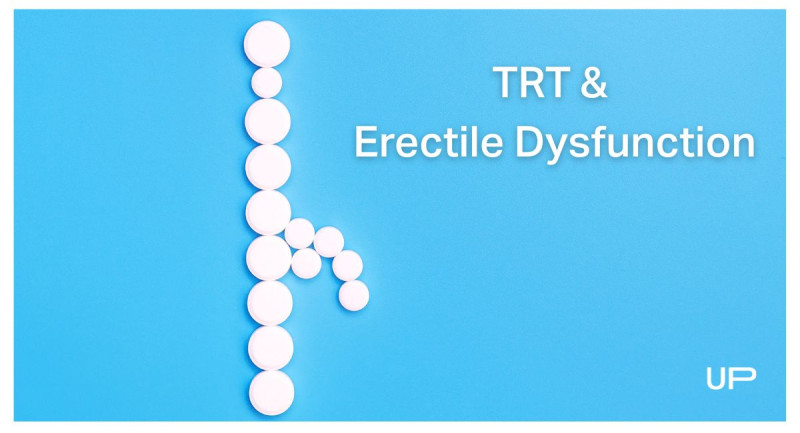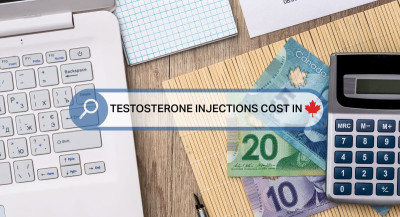TRT And Erectile Dysfunction: Can Testosterone Help?


Erectile dysfunction (ED) and low testosterone are two of the most common health concerns for men over 40 in Canada. Because they can share similar symptoms, like reduced libido and poor sexual performance, it’s easy to assume that one causes the other.

However, that’s not always the case. While low testosterone (or “low T”) can contribute to ED, many men experience ED for other reasons, such as blood flow issues, stress, or underlying health conditions.
Testosterone replacement therapy (TRT) in Canada can be an effective option for some, but it’s not always the first treatment doctors recommend. This article breaks down how to tell the difference and when TRT might actually help.
Topics covered in this article:
- Why ED Happens More Often After 40
- When Low Testosterone Is the Culprit
- Can TRT Treat Erectile Dysfunction?
- Other ED Treatments to Consider
- TRT and Heart Health: What Men Need to Know
- How UPGUYS Helps with ED and TRT
- Conclusion: Know Your Options, Treat the Root Cause
- FAQs About TRT and Erectile Dysfunction
- References
Why ED Happens More Often After 40
Erectile dysfunction (ED) becomes more common after age 40 due to a combination of physical and psychological factors. For many Canadian men, it is not just about aging but about what changes in the body and mind during midlife.

Some of the most common physical causes include:
- Reduced blood flow due to vascular disease
- Diabetes and related nerve damage
- Side effects from medications such as antidepressants or blood pressure drugs
Psychological factors are just as important. Chronic stress, performance anxiety, low self-esteem, or relationship tension can all interfere with the brain’s ability to trigger an erection.
Low testosterone is sometimes part of the picture, but it is not always the primary cause. In fact, many men with normal testosterone levels still experience ED, while others with low T do not. This is why it’s important to get proper testing before assuming testosterone replacement therapy (TRT) is the right fix.
When Low Testosterone Is the Culprit
While erectile dysfunction (ED) often has multiple causes, low testosterone can sometimes be a key contributor, especially when it comes with other symptoms. Men in Canada experiencing persistent fatigue, low libido, reduced muscle mass, or mood changes alongside ED may be dealing with testosterone deficiency.
To confirm this, healthcare providers will order blood tests to measure total and free testosterone levels, usually taken in the morning when levels are highest. If results show consistently low testosterone and symptoms match, a diagnosis of hypogonadism may be made.
Starting testosterone replacement therapy (TRT) in Canada requires more than just a low number. Doctors look at the full clinical picture, including symptoms, lab values, and overall health. TRT is typically considered when:
- Total testosterone levels fall below the normal reference range (often under 8 to 12 nmol/L, depending on the lab)
- Symptoms are significant and persistent
- Other treatable causes of low testosterone have been ruled out
TRT may help improve sexual function in men with confirmed low T, but it is not a universal solution for ED on its own.
Can TRT Treat Erectile Dysfunction?
Testosterone replacement therapy (TRT) can help with erectile dysfunction, but only in certain cases. The key factor is whether a man has clinically confirmed low testosterone. If testosterone levels are normal, TRT is unlikely to improve erections and may carry unnecessary risks.

Most evidence shows that TRT is not a first-line treatment for ED. Medications like sildenafil (Viagra) or tadalafil (Cialis) are more effective for the majority of men, especially when ED is caused by blood flow problems or nerve damage. However, in men with documented low testosterone and symptoms like low libido or reduced morning erections, TRT may lead to:
- Improved sexual desire
- Better mood and energy
- Slight improvements in erection quality
Still, results vary. TRT doesn’t work overnight, and it may take several months to see full effects. For men with both low T and ED, combining TRT with ED medications often provides the best results.
Other ED Treatments to Consider
Testosterone replacement therapy (TRT) is just one option in a broader toolkit for treating erectile dysfunction (ED). In Canada, most men benefit from a combination of medical and lifestyle approaches tailored to the root cause of their ED. Common and effective treatments include:
- Oral Medications: Drugs like Viagra (sildenafil) and Cialis (tadalafil) are often the first-line option. They increase blood flow to the penis and are effective for many types of ED.
- Lifestyle Changes: Weight loss, quitting smoking, cutting back on alcohol, and getting regular exercise can significantly improve erectile function. These changes also support heart health, which is closely linked to sexual performance.
- Therapy and Stress Management: When anxiety, depression, or relationship stress contribute to ED, counselling or sex therapy can help. Mental health plays a bigger role in sexual function than many men realize.
- Newer Treatments: For those who don’t respond to pills, other therapies are available. These include penile injections, vacuum erection devices, and low-intensity shockwave therapy. Each has its pros and cons and may be recommended based on individual needs.
Exploring these options with a healthcare provider ensures you get a personalized treatment plan that actually works—whether or not testosterone is part of the equation.
TRT and Heart Health: What Men Need to Know
Erectile dysfunction (ED) can often be an early warning sign of cardiovascular disease. That’s because both conditions are linked to poor blood flow. For men over 40 in Canada, understanding this connection is critical—especially if they’re considering testosterone replacement therapy (TRT).
Low testosterone itself isn’t necessarily harmful to the heart, but its treatment has sparked debate. While early studies raised concerns about TRT increasing the risk of heart attack or stroke, more recent research suggests that TRT may actually improve heart health in men with clinically low testosterone—especially when prescribed appropriately and monitored by a doctor.
If you have pre-existing heart conditions or risk factors like high blood pressure or diabetes, it’s vital to:
- Get a full cardiovascular evaluation before starting TRT.
- Follow medical guidance closely during treatment.
- Avoid self-medicating or increasing your dose without supervision.
With the right screening and monitoring, TRT can be used safely—even in men with heart risks. But skipping proper care and oversight isn’t worth the gamble.
How UPGUYS Helps with ED and TRT
For men in Canada navigating erectile dysfunction and low testosterone, UPGUYS offers a trusted, accessible solution.
Our platform connects patients with licensed Canadian doctors who specialize in testosterone replacement therapy (TRT) in Canada. Every treatment plan is personalized, starting with lab testing and thorough assessments to ensure TRT is appropriate.

UPGUYS supports at-home care with no surprise fees. There are no charges for consultations, lab requisitions, or shipping.
Prescriptions, whether for ED medications or testosterone, are delivered discreetly to your door. Follow-ups and dosage adjustments are built into the process, ensuring your treatment stays safe and effective.
This model simplifies access to ED and TRT care for men across Canada, especially those seeking clarity, transparency, and convenience.
Conclusion: Know Your Options, Treat the Root Cause
Erectile dysfunction is common, and while testosterone replacement therapy (TRT) in Canada can help in some cases, it’s not a one-size-fits-all solution. The key is identifying the true cause of the problem through proper testing and medical evaluation. Whether your ED is linked to low testosterone, stress, circulation issues, or something else, effective treatments exist. Talk to a licensed healthcare provider, explore your options, and take the first step toward improving your sexual health and confidence.
FAQs About TRT and Erectile Dysfunction
Yes, but not always. Low testosterone can affect sexual desire and sometimes erectile function, but most cases of ED are related to blood flow issues, stress, or other health problems. That’s why proper testing is essential before starting testosterone replacement therapy (TRT).
TRT is only recommended if blood tests confirm low testosterone levels and symptoms align. If your testosterone is normal, other ED treatments are usually more effective. Your doctor will consider your full health picture before suggesting TRT.
Not typically. TRT may take several weeks or months to improve symptoms, and it may not fully resolve ED unless low testosterone is the root cause. Some men see faster results when combining TRT with ED medications like Viagra or Cialis.
For most men, yes. ED medications like sildenafil (Viagra) or tadalafil (Cialis) work directly on blood flow and usually produce faster results. TRT is more helpful when ED is caused by low testosterone and reduced libido, not just performance issues.
UPGUYS connects men with licensed Canadian doctors for online consultations, lab testing, and personalized treatment plans. If you’re a candidate for TRT or need ED medications, everything from prescriptions to follow-ups is managed through a convenient and discreet platform.
References
UPGUYS has strict sourcing guidelines to ensure our content is accurate and current. We rely on peer-reviewed studies, academic research institutions, and medical associations. We strive to use primary sources and refrain from using tertiary references.- Long Term Cardiovascular Safety of Testosterone Therapy: A Review of the TRAVERSE Study, The World Journal of Men's Health,
https://wjmh.org/pdf/10.5534/wjmh.240081?utm_source=chatgpt.com - Androgen Society Position Paper on Cardiovascular Risk With Testosterone Therapy, Mayo Clinic,
https://www.mayoclinicproceedings.org/article/S0025-6196%2824%2900408-7/fulltext?utm_source=chatgpt.com - Relationship Between Testosterone and Erectile Dysfunction, PubMed,
https://pmc.ncbi.nlm.nih.gov/articles/PMC1476110/
This article is written for informational purposes only and does not constitute medical advice. The information provided in the articles cannot and should not replace advice from a healthcare professional. Talk to your healthcare provider about any physical or mental health concerns or the risks and benefits of any treatment or medication.





